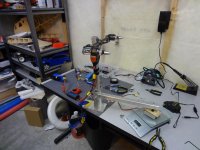!8% overlap.. or 40% overlap. could you please explain. Does this mean a coaxial with a bigger prop on one than on the other?
I tested with an 18% overlap, and showed a much lower amount of efficiency loss than coaxial. Theoretically, you can get up to a 40% overlap before you start to lose efficiency. In fact, the theory (using a whole lot of complicated math) shows that you could actually have *more* thrust with 20-30% overlap than with the props fully spread.
I suspect the efficiency loss for the overlap in my testing might be closer to 0, because my single motor test was just that, a single motor, and then I simply doubled the thrust and energy numbers to do the comparison. But I'm not sure that was actually a fair test, because the power system might have been more efficient at supplying the single motor, than two. ie: the voltage drop through the battery would be lower when supplying half the power, thus, voltage supplied to the motor would be higher, making it more efficient. What I really need to do is test two motors running simultaneously, with a full spread. And then run with the overlap.
In fact I did do this test. But with a hitch. I was using a nice digital servo tester, with PWM readout to drive the ESC's. But it died just as I was setting up for the two-motor-full-spread test.

I then used an analog servo tester to drive the ESC's, but I couldn't see the actual PWM number. What I did was try to match the watts being consumed during each step of the overlap test, and then record the thrust being produced. This test did show what I suspected. That running like this, the overall system efficiency was very close to that of the overlapping test. But I didn't think it fair to present the data since it was using a completely different method.
There were a few other issues with the test. With a single 4S 5000 battery supplying a single motor, the voltage drop on the battery was not realistic (it was lower than it would be with my planned 2 batteries for 8 motors). This meant during the single motor test, it was overloading, and I had to stop at 1800 PWM. This confirms my thoughts above about the single motor test being more efficient. Therefore, I limited all the tests to 1800 PWM. So it doesn't cover the full load, though really you should never fly over 80% anyway, because you need the top 20% for stabilization. Frankly I think you shouldn't go over 50% or you start to seriously jeopardize your ability to withstand a motor failure.
I originally thought the inability to run at 2000 PWM with the 13" props showed that the eCalc was not accurate. Now I realize that's not true. The number of motors per battery is a critical part of the equation, because it determines to voltage drop within the battery. The voltage getting to the motor depends quite strongly on the number of cells providing the power. eCalc actually shows this very clearly. For a given setup, as you increase the number of cells, the motor power goes up. I didn't fully understand this at the time. Now I do.
The typically quoted figure for efficiency loss with coaxial motors is 20-30%. I tested it and found it to be about 20-25%.
However, there is further analytical theory, that much of the coaxial efficiency loss can be re-gained by increasing the pitch of the bottom props. Say, run a 12x4.5 on top, and a 12x6 on the bottom. This is because the airstream entering the bottom propeller has a much higher vertical velocity than that on top.
Very interesting. I was always curious about prop overlap and will it actually work. Man you'd have a much smaller octo. I may test this soon by simply shortening the booms and rotating every other arm so that 4 motors ae facing upward and 4 are facing ground.
That's *exactly* what I was planning to do. However, as MombasaFlash pointed out, the problem is with the motors getting in the picture. It's hard to escape this, and is why the design really won't work. However, there is another method. I tested both with the "motor flipped upside down" method, and then I also had them both pointed "up", but with one of them mounted on 30mm aluminum spacers. I couldn't really detect any difference in performance or any other distinguishing difference. You can see this as pictured below. The only downside is that it looks a bit ugly.
View attachment 6266
So, currently my octo design has a motor diameter of 950mm, which is typical of 12" prop machines. It's huge, and I didn't design it to fold. However, if I go with a 20% overlap, I can shrink the diameter to 630mm which obviously has a huge advantage. I'm only uncertain about the flight stability with the smaller diameter. The advantage of the smaller size also brings with it overall airframe stiffness.
- nothing about AP in there! I assume you just meant "single rotor"?

